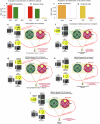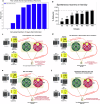A neurally constrained computational model of context-dependent fear extinction recall and relapse
- PMID: 40287569
- PMCID: PMC12033332
- DOI: 10.1038/s42003-025-08107-7
A neurally constrained computational model of context-dependent fear extinction recall and relapse
Abstract
Exposure therapy, a standard treatment for anxiety disorders, relies on fear extinction. However, extinction recall is often limited to the spatial and temporal context in which extinction is learned, leading to fear relapse in new settings or after delays. Animal studies offer insights into fear extinction in humans. Computational models that integrate these findings into a neurally grounded framework, while generating testable hypotheses for humans, can bridge this gap. Current models either focus on neuron-level activity, limiting their scope, or abstract away entirely from neural mechanisms. They also often overlook the distinct contributions of cue and context in fear extinction and recall. To address these gaps, we present ConFER, a neurally constrained model of fear extinction, recall, and relapse. ConFER integrates findings from the neural fear circuit, modeling distinct pathways for cue and context processing. These pathways independently activate positive and/or negative memory engrams in the basolateral amygdala, competing to determine the fear response. ConFER simulates fear renewal and spontaneous recovery across context combinations, while generating novel, testable predictions. Notably, it predicts counterconditioning may better prevent relapse than extinction in new contexts or after delays. By mechanistically modeling fear relapse, ConFER offers insights to improve exposure therapy outcomes.
© 2025. The Author(s).
Conflict of interest statement
Competing interests: The authors declare no competing interests.
Figures





Similar articles
-
Multiple extinction contexts modulate the neural correlates of context-dependent extinction learning and retrieval.Neurobiol Learn Mem. 2020 Feb;168:107150. doi: 10.1016/j.nlm.2019.107150. Epub 2019 Dec 24. Neurobiol Learn Mem. 2020. PMID: 31881356
-
Medial prefrontal pathways for the contextual regulation of extinguished fear in humans.Neuroimage. 2015 Nov 15;122:262-71. doi: 10.1016/j.neuroimage.2015.07.051. Epub 2015 Jul 26. Neuroimage. 2015. PMID: 26220745 Free PMC article.
-
Distinct hippocampal engrams control extinction and relapse of fear memory.Nat Neurosci. 2019 May;22(5):753-761. doi: 10.1038/s41593-019-0361-z. Epub 2019 Apr 1. Nat Neurosci. 2019. PMID: 30936555 Free PMC article.
-
Neural circuits involved in the renewal of extinguished fear.IUBMB Life. 2017 Jul;69(7):470-478. doi: 10.1002/iub.1636. Epub 2017 May 2. IUBMB Life. 2017. PMID: 28464461 Review.
-
The role of the basolateral amygdala and infralimbic cortex in (re)learning extinction.Psychopharmacology (Berl). 2019 Jan;236(1):303-312. doi: 10.1007/s00213-018-4957-x. Epub 2018 Jun 30. Psychopharmacology (Berl). 2019. PMID: 29959461 Review.
References
-
- Foa, E. B., Hembree, E. A. & Rothbaum, B. O. Prolonged Exposure Therapy for PTSD: Emotional Processing of Traumatic Experiences: Therapist Guide. viii, Vol. 146 10.1093/med:psych/9780195308501.001.0001 (Oxford University Press, 2007).
MeSH terms
LinkOut - more resources
Full Text Sources
Miscellaneous

